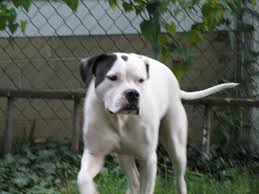
Although called the American Bulldog, this breed was, in fact, created by crossbreeding the English Mastiff with the Spanish Alaunt dog. The breed was used for guarding and as a chase dog, and when the immigrants came to America, they brought their dogs with them in the Southern and Middle-Western farms in America. From the initial and original Bulldogs, three distinct types have evolved: the classic type, the standard type - also called the performance type, and the Hybrid type. Their aspect can be easily mistaken with that of Pit Bulls, but a breeder can easily see the differences between those two, and recognize them immediately.
Short legged, but robust and surprisingly agile, the American Bulldog is taller than the English bulldogs. The head is square, wide, with right angles and powerful jaws, a strong muscular neck and a prominent chest. The ears can be cropped or not, the eyes are usually dark in color, but can sometimes be each of a different color, a genetic trait called heterochromia. The coat is soft and short. The color variation is quite large, including white, black, brown, tan and sometimes a little pink and all shades of brindle, fawn and red. Solid black, merle or blue are considered a fault, and for the American Bulldog who has such colors, it means disqualification from the breed standard. They weigh between 27 and 54 kg, and are 52-70 cm tall, but it is known that they can easily outgrow these dimensions, especially the dogs that are not very active.
Being the breed used to protect their live stock, the dogs should be well trained before becoming part of a family. It is to be noted that they were used in dog fights, and that is because they tend to be very aggressive dogs when encouraged. They act fine around children, but they need early socialization with their families in order to get a clearly established hierarchy in their minds and understand the limits allowed.
The American Bulldog could be a little aloof with strangers and its determination to guard the assets and the pack could create problems with new-comers, if they have not been properly introduced. A good practice that guarantees the success of socialization is to frequently expose the dog to new-comers, children and various pets from early ages, in order to get them used to possible changes in the environment around them and not to become too alert if something new should happen.
Another good practice is to take them on daily walks in populated places like parks, not avoiding the rush hours, because they can develop an aggressive behavior towards other dogs or people if not properly socialized. The training is usually not a problem, because they are obedient dogs and as puppies they have a friendly behavior, but they can be very territorial and very dominant if they are allowed to be.
In conclusion, an American Bulldog can be a precious jewel or a menace, it depends on the leader, and that is why, if you fall in love with such a dog, it is advisable to train it before bringing it to your place.




